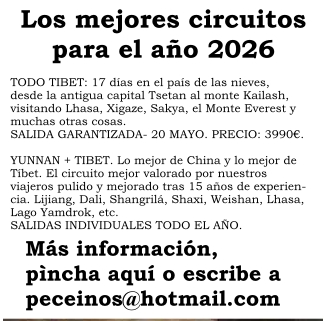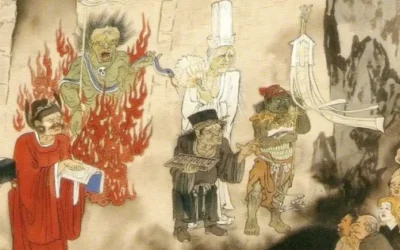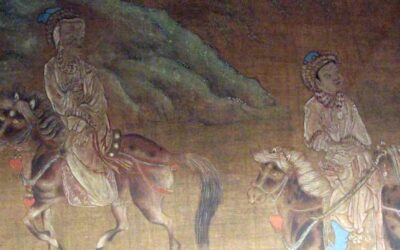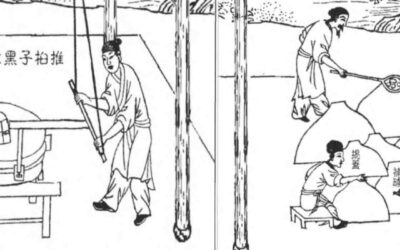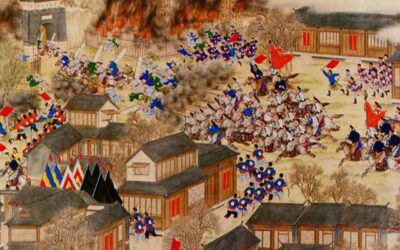On the left side was a densely wooded rocky hill. Its steep slope was carved into fantastic figures of unicorns, leogryphs and other mythological animals, and statues of gods and saints. They had been fashioned out of rock by the monks more than fifteen centuries ago. Under the hill were grottoes and caves filled with Buddhas and genii, where pilgrims were burning incense. Mantras in Sanskrit and archaic Chinese adorned the rocks, chiselled by the long departed hermits.]
Walking a little farther we came to the spacious entrance hall of a monastery which was unique in China in its grandeur, sanctity.
‘The Monastery of the Spirit’s Retreat’, softly exclaimed Chungan pointing to the three huge golden characters over the wide-open doors of the hall.
‘What a deep and secret meaning these words possess ! ‘ he continued. ‘It is a fitting name for this place, for it is difficult to conceive a better hermitage for the spirit of a man tired of the world and seeking concealment amidst the beautiful and tranquil.
Having emerged from this hall with its golden statue of Maitreya, the Lord Buddha of the Future, we stepped out into a large stone-flagged courtyard bounded by ancient trees. In front of them, on a high stone platform, flanked by two small pagodas and with a massive bronze incense burner in the middle, stood the main temple hall. its great height and immense size dwarfed all other buildings around it. The roof rose in three nobly curved tiers supported by colossal red wooden pillars.
The latticed gates of the hall were open as we came in. A mysterious semi-darkness, heavy with the odour of sandal-wood incense, pervaded the place. Right in the middle of the vast temple sat three golden Buddhas of such unbelievable majesty and of such gigantic proportions that when I saw them I was astonished. The images rested on lotus flowers which, in turn, were supported by stupendous stone pedestals. A colossal lantern, richly carved and decorated, with a perpetually-burning oil-lamp within, was suspended in front of the Trinity.
The central figure was that of the Lord Buddha himself with his royal coiffure and a sign of urna on his forehead. With the eyes turned inwards, gazing not at the world outside before him but at the world within himself; with his enigmatic smile, he sat there a true image of the man that he once was, but who had transcended all human emotions, desires, all suffering and mundane joy; who had found the lost path to Heaven and shown it to suffering mankind, and who at last had entered Nirvana and became himself a God. I gazed enchanted at the mystic statue. I felt mesmerized by the utter stillness of the temple. Clouds of incense floated in spirals towards the lofty ceiling and gently dissolved there in the golden rays of the sun coming through the narrow windows. The very silence was pregnant with the meaning of things unsaid, of prayers uttered and of petitions yet unoffered.
After we had finished our tour of the golden statues of arhats, lining the walls, and paused before an enormous image of the gentle Goddess Kwanyin, which stood against an altar piece representing the Western Paradise, we made our exit by a side door into a commodious guest hall where a young novice brought us cups of the monastery’s own tea. He smiled at Chungan and Tsungpoo, evidently recognizing them as frequent visitors. After a good rest we were ready to proceed to the next famous temple.
Goullart, Peter. Monastery of the Jade Mountain.
Peter Goullart. The monastery of Jade Mountain.
More posts on Chinese culture
Herboristeria de medicina china en Weishan, Yunnan
Herboristeria de medicina china en Weishan, Yunnan Todavía se mantiene en China una gran tradición de uso de las medicinas naturales, es decir de las hierbas con propiedades medicinales que se han utilizado desde hace siglos. Y además de estar presentes en la...
Tratar enfermedades con la almohada de un cadáver
LLa Tratar enfermedades con la almohada de un cadáver En una biografía de Xu Sibo[1], un especialista taoísta en terapia con agua[2] del siglo V de nuestra era, leemos: "Había una matrona que sufría de estreñimiento incurable desde hacía muchos años, y cuando Sibo...
La tragedia de la belleza Wang Zhaojun
La tragedia de la belleza Wang Zhaojun El emperador Yuan (48–33 a.C.) tenía un gran harén y no podía reunirse con todas las mujeres del palacio con regularidad. Por lo tanto, ordenó a los pintores que crearan retratos de ellas, y las convocaba para favores basándose...
La economía del arado humano en la China del siglo XVII
La economía del arado humano Según La explotación de las obras de la naturaleza, un libro chino del siglo XVII: En los hogares agrícolas donde no hay bueyes disponibles, los campesinos fijan un palo al arado y dos hombres lo tiran colocándolo sobre sus hombros,...
La rebelión musulmana en Yunnan en el siglo XIX
La rebelión musulmana en Yunnan en el siglo XIX. Esta es la primera traducción al inglés del libro de Émile Rocher sobre la Rebelión Panthay. Publicado originalmente en 1879 como La Province chinoise du Yunnan, es un valioso testimonio de primera mano sobre Yunnan a...
Escenas callejeras de Kunming, Yunnan
Vendedor de ostras en mercado nocturno. Kunming. China. En los últimos años China se ha convertido en uno de los principales consumidores de pescado. Eso ha hecho que incluso en las zonas del interior sea bastante común encontrar pescados y mariscos de mar,...
More posts on China ethnic groups
Herboristeria de medicina china en Weishan, Yunnan
Herboristeria de medicina china en Weishan, Yunnan Todavía se mantiene en China una gran tradición de uso de las medicinas naturales, es decir de las hierbas con propiedades medicinales que se han utilizado desde hace siglos. Y además de estar presentes en la...
Tratar enfermedades con la almohada de un cadáver
LLa Tratar enfermedades con la almohada de un cadáver En una biografía de Xu Sibo[1], un especialista taoísta en terapia con agua[2] del siglo V de nuestra era, leemos: "Había una matrona que sufría de estreñimiento incurable desde hacía muchos años, y cuando Sibo...
La tragedia de la belleza Wang Zhaojun
La tragedia de la belleza Wang Zhaojun El emperador Yuan (48–33 a.C.) tenía un gran harén y no podía reunirse con todas las mujeres del palacio con regularidad. Por lo tanto, ordenó a los pintores que crearan retratos de ellas, y las convocaba para favores basándose...
La economía del arado humano en la China del siglo XVII
La economía del arado humano Según La explotación de las obras de la naturaleza, un libro chino del siglo XVII: En los hogares agrícolas donde no hay bueyes disponibles, los campesinos fijan un palo al arado y dos hombres lo tiran colocándolo sobre sus hombros,...
La rebelión musulmana en Yunnan en el siglo XIX
La rebelión musulmana en Yunnan en el siglo XIX. Esta es la primera traducción al inglés del libro de Émile Rocher sobre la Rebelión Panthay. Publicado originalmente en 1879 como La Province chinoise du Yunnan, es un valioso testimonio de primera mano sobre Yunnan a...
Escenas callejeras de Kunming, Yunnan
Vendedor de ostras en mercado nocturno. Kunming. China. En los últimos años China se ha convertido en uno de los principales consumidores de pescado. Eso ha hecho que incluso en las zonas del interior sea bastante común encontrar pescados y mariscos de mar,...

